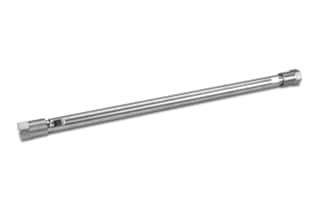
|
Chemistry |
GPC |
|
Separation Mode |
SEC/GPC |
|
Particle Substrate |
Polymer |
|
pH Range Min |
2 pH |
|
pH Range Max |
12 pH |
|
Molecular Weight Range Min |
200000 |
|
Molecular Weight Range Max |
10000000 |
|
Particle Shape |
Spherical |
|
Particle Size |
5 µm |
|
Endfitting Type |
Waters |
|
Pore Size |
1000000 Å |
|
Format |
Column |
|
Packing Solvent |
THF |
|
System |
HPLC |
|
Inner Diameter |
7.8 mm |
|
Length |
300 mm |
|
UNSPSC |
41115709 |
|
Brand |
Styragel |
|
Product Type |
Columns |
|
Units per Package |
1 pk |

Styragel GPC Column, 5 µm, 7.8 mm X 300 mm, 200K - 10M, 1/pk
Styragel HR columns are high-resolution GPC columns packed with 5 µm particles that are ideal for characterizing samples in the low- to mid-molecular range when high resolution is required. When high resolution is required, use the Styragel HR column, which is a high-resolution GPC column packed with 5 µm particles and is ideal lab equipment for characterizing samples in the low- to mid-molecular range.
Waters has spent decades conducting extensive research to improve GPC analysis by refining the instrumentation, packing materials, and technology. This has resulted in innovations like the size-exclusion techniques used in the Styragel HR column, that allow you to go beyond the original polymer analysis to include applications for separating small and large molecules from interfering matrices. Foods, pharmaceutical preparations, and natural products all comprise these.
Waters provides you with the highest quality GPC products and expert application support, so you can rely on the Styragel HR column for accurate and precise results. As all of our facilities meet strict ISO, FDA, and cGMP guidelines, the Styragel HR column is manufactured under the most stringent conditions to ensure that you receive the highest quality chromatographic instrumentation and consumables. You can browse through our catalog or scroll through our website to review the lab equipment available from Waters and shop for lab equipment as per your lab needs.
You might also be interested in reviewing the Waters Preparative Chromatography Mix Standard; the Quality Control Reference Material portfolio is a unique collection of standards and mixtures that allow the user to evaluate and benchmark their chromatography system before analysis of critical material. The Preparative Chromatography Standard is 5 mg/mL each of Diclofenac sodium salt, Diphenhydramine hydrochloride, and Flavone in DMSO-- this standard mix should be used to confirm the benchmark performance of your preparative or purification system. This particular QC Reference Material is a specially formulated mix that includes a void marker, neutral, acidic, and basic compounds. It can be used with a variety of column chemistries, dimensions, and system hardware.
How Could Enrichment in Sample Components Present in Low Concentration Be Improved?
There are several steps that can be taken to enrich sample components that are present in low concentrations. You can tailor the gradient steps to selectively elute analytes. Another effective approach is to use "large" sample volumes in an adsorption-promoting solvent. Use a "small" collection volume in a desorption-promoting solvent. Use analyte-specific sorbent chemistry that is independent of the sorbent chemistry used in the analytical column. The chemistry of the solid-phase extraction column should be carefully selected so that no supplemental sample preparation is required.